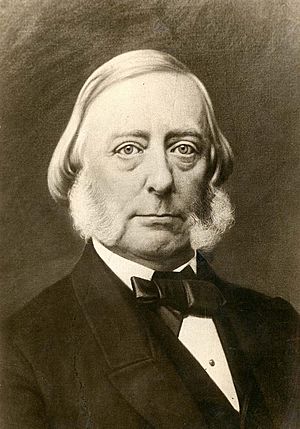Andrew Horatio Reeder facts for kids
Quick facts for kids
Andrew H. Reeder
|
|
|---|---|
 |
|
| 1st Territorial Governor of Kansas | |
| In office July 7, 1854 – August 16, 1855 |
|
| Preceded by | Office established |
| Succeeded by | Wilson Shannon |
| Personal details | |
| Born | July 12, 1807 Easton, Pennsylvania, U.S. |
| Died | July 5, 1864 (aged 56) Easton, Pennsylvania, U.S. |
| Political party | Democrat (until 1860) Republican (from 1860) |
| Spouse | Amalia Hutter |
| Profession | attorney, soldier |
| Signature | |
Andrew Horatio Reeder (born July 12, 1807 – died July 5, 1864) was an important American politician. He is best known as the very first governor of the Kansas Territory.
Contents
Andrew Reeder's Early Life
Andrew Reeder was born in Easton, Pennsylvania. His parents were Absolom and Christina Reeder. He went to school at an academy in Lawrenceville, New Jersey. After school, he studied law in a lawyer's office. He became a lawyer in 1828. In 1831, he married Frederika Amalia Hutter. They had ten children together, three sons and seven daughters.
Reeder's Political Career
Andrew Reeder was a strong supporter of the Democratic Party. He believed in something called popular sovereignty. This idea meant that people living in a new territory should get to decide for themselves if their territory would allow slavery.
Becoming Governor of Kansas
On June 29, 1854, President Franklin Pierce chose Reeder to be the governor of the Kansas Territory. Reeder took his oath of office on July 7, 1854. He arrived in Kansas on October 7. He served as governor until August 16, 1855.
Challenges in Kansas
As governor, Reeder supported the Kansas–Nebraska Act. This law said that people in the Kansas and Nebraska territories could vote to decide if slavery would be allowed there. This was a very controversial issue at the time.
On March 30, 1855, a big problem happened during an election. Many people from nearby Missouri came into Kansas illegally. They voted to try and make Kansas a slave state. Governor Reeder saw this as cheating. He refused to accept the results of this unfair vote. He asked for a new election to fill some open positions. He also chose a new meeting place for the first territorial government.
Dismissal and Later Life
President Pierce removed Reeder from his job. This happened because Reeder refused to help make Kansas a slave state. In May 1856, Reeder faced serious accusations. He left Kansas disguised as a woodchopper to avoid trouble.
Reeder went back to Pennsylvania. He stayed active in politics and joined the new Republican Party. In 1860, he even received some votes to become the Republican candidate for Vice President.
Death
Andrew Horatio Reeder passed away in Easton, Pennsylvania, on July 5, 1864. He is buried in Easton Cemetery. A street in Easton, Reeder Street, is named after him.

